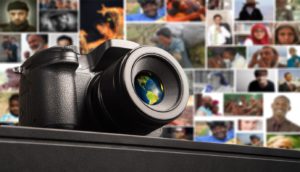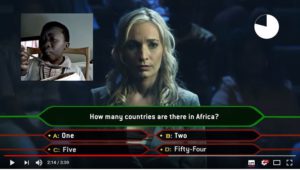Rachel Bossmeyer is currently doing her MA in Postcolonial Studies at SOAS. Coming from a communications and politics background her research focuses on critical media analyses of foreign reporting, the representation of ethnic minorities in German and European media as well as racialized instrumentalization of gender in media and politics.
Flipping through the pages of a mainstream Western newspaper or magazine, clicking through news on TV or listening to the radio, one will barely ever read or hear about Africa. It seems that the continent is not “newsworthy”[1]. But how can it be that a whole continent, composed of 55 countries and more than a billion people, gets so consistently ignored by Western media? It is what Hagos calls the “legacy of neglect” which in consequence makes Africa the most marginalized region in Western press[2]. With Global Media and World News on the rise, gathering a far larger audience than most works from other literary genres can draw, journalistic representation becomes ever more important. So how is the African continent represented when it does appear? Which topics make it to the news? Which frames are used?

The Construction of geographical spaces in Media
First of all, most of the news that are presented to us are negative. They center on topics of war, conflict, humanitarian crises, death and catastrophes. Whilst these often have a material basis, their distorted appearance in the news, juxtaposed with the lack of any positive or everyday live coverage contributes enormously to the misrepresentation of Africa as a “hopeless continent” as The Economist dared putting it in 2000. The exclusive focus on these negative issues is what scholars call Afro-Pessimism. However, the danger of this type of reporting lies not only in creating a warped and biased image, but rather in enforcing international political dependencies – by engraving the image of a continent unable to deal with its own problems thus requiring help from the outside. Furthermore, these narratives depict a continuing colonial discourse, which hasn’t changed sufficiently over the past fifty years[3].
When confronted with these findings, journalists often refer to structural practices in the industry and the sheer impossibility of covering all topics and aspects. Nonetheless, journalists have an active role in filtering relevant from less relevant topics in what is called gatekeeping. It seems obvious, but worth mentioning, that the social environment of each individual writer influences the way they select news. Therefore, it is necessary to bear in mind, that media is not separate from ongoing discourse in society, and is thus likely to engage in a hegemonic discourse. Explaining the principles of news selection, media scholars found that certain topics seem to have a higher news value than others and that negative news seems to dominate in general. However, this cannot explain why images in magazines or TV shows about African countries and Africa as a whole do not differ substantially from those in news. Whilst the negative component dominates all types of coverage, other formats offer more varied topics, however often not less stereotypical. Common themes are sexuality and the focus on nature and landscapes, the latter creating the image of a land without people, without voices and subjectivities, and a contrast-reading to urban images of Europe. Thus, these reports equally push Africa to the margin of modernity and erase their peoples’ subjectivity. The most prominent example for this is ethnographic exotisizing and objectifying reports focusing on tribes, creating an image of primitiveness. About ten years ago, Wainaina pointed out how absurd and deeply discriminating the coverage can get when giving satirical advice on How to write about Africa. Today’s coverage stills seems to fit into what Hall called the asymmetrical discourse of “the West and the Rest”[4] which was to a large part spread and perpetuated by literary accounts.

Satirical adaption of Western images of Africa in Who Wants to be a Volunteer by SAIH Norway and NEFDT Film.
Several important aspects must be addressed in order to change Western media’s image of Africa. As media discourse is part of a larger interacting societal discourse and a mutual influence between the two exist, we seem to be stuck in a vicious circle. However, reflecting on one’s own preconceptions and stereotypes – decolonizing one’s mind – will help avoid recreating discriminative narratives. History must be reassessed and reinterpreted and the way media and language were used as tools of domination in colonialism must be acknowledged. The complicity of the written word in the assertion of power must be understood. Furthermore, a more differentiated image of African countries is needed. As Ngozi Adichie pointed out, there is not just one “single story of Africa” but a multiplicity. Additionally, the focus must be placed on everyday life, on sports, on business, on regional politics – on everything that is emphasized in other regions of the world as well, embracing African countries as significant geographies rather than Europe’s periphery. Finally, for this to happen, Western media must rely more on local journalists and experts instead of practicing narrow parachute journalism. This will not only allow for a more accurate and in-depth coverage, but will equally give voice to people who have formerly been the objects rather than the subjects of Western media’s stories.
[1] Köpp, Dirke (2004): “Keine Hungersnot in Afrika” hat keinen besonderen Nachrichtenwert (No Famine in Africa has any special News Value). Afrika in populären deutschen Zeitschriften (1946-2000) (Africa in popular German Magazins (1946-2000)). Frankfurt; Oxford: Peter Lang.
[2] Hagos, Asgede (2000): Hardened Images. The Western Media and the Marginalization of Africa. Trenton; Asmara: Africa World Press: 2.
[3] Kalyango, Yusuf, JR.; Onyebadi, Uche (2012): Thirty Years of Broadcasting Africa on U.S. Network Television News. In: Journal of Broadcasting & Electronic Media 56 (4), p. 669–687.
Köpp, Dirke (2004): “Keine Hungersnot in Afrika” hat keinen besonderen Nachrichtenwert (No Famine in Africa has any special News Value). Afrika in populären deutschen Zeitschriften (1946-2000) (Africa in popular German Magazins (1946-2000)). Frankfurt; Oxford: Peter Lang.
[4] Hall, Stuart (1992): The West and the Rest: Discourse and Power. In Stuart Hall and Bram Gieben (Ed): Formations of modernity. Oxford: Polity in association with Open University, p. 275-332.
Bunce, Mel; Franks, Suzanne; Paterson, Chris (2017): Africa’s Media Image in the 21st Century. From the “Heart of Darkness” to “Africa Rising”. Abingdon: Routledge, p. 1- 13.
Hagos, Asgede (2000): Hardened Images. The Western Media and the Marginalization of Africa. Trenton; Asmara: Africa World Press.
Hall, Stuart (1992): The West and the Rest: Discourse and Power. In Stuart Hall and Bram Gieben (Ed): Formations of modernity. Oxford: Polity in association with Open University, p. 275-332.
Ibelema, Minabere (2014): “Tribal Fixation” and Africa’s Otherness. Changes and Resilience in News Coverage. In: Journalism & Communication Monographs 16 (3), p. 162–217.
Kalyango, Yusuf, JR. (2011): Critical Discourse Analysis of CNN International’s Coverage of Africa. In: Journal of Broadcasting & Electronic Media 55 (2), p. 160–179.
Kalyango, Yusuf, JR.; Onyebadi, Uche (2012): Thirty Years of Broadcasting Africa on U.S. Network Television News. In: Journal of Broadcasting & Electronic Media 56 (4), p. 669–687.
Keim, Curtis; Somerville, Carolyn (2017): Mistaking Africa. Curiosities and Inventions of the American Mind. 4. Edition. New York: Westview Press.
Köpp, Dirke (2004): “Keine Hungersnot in Afrika” hat keinen besonderen Nachrichtenwert (No Famine in Africa has any special News Value). Afrika in populären deutschen Zeitschriften (1946-2000) (Africa in popular German Magazins (1946-2000)). Frankfurt; Oxford: Peter Lang.


Leave A Comment